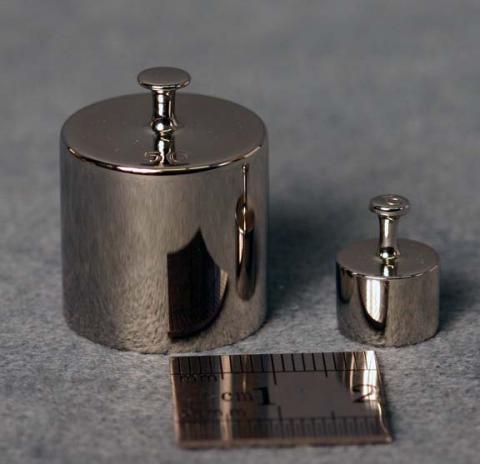Analytical Balance Weights, 5g & 50g
Analytical Balance Weights, 5g & 50g
Class M, NBS Certified
William Ainsworth
provenance: Humboldt College; 1962
Usage
Class M weights are intended as primary laboratory standards and for the very highest quality work. M Class weights are of single piece construction so that their mass tends to be more stable than othe weights which are made in two pieces to allow for adjustment. Single piece construction makes it more difficult to adjust the weights, raising their cost. M Class weights are also held to higher precision for most denominations. This set includes rodium plated bronze 1–100 g weights, aluminum 1–20 and tantalum 50–500 mg fractional weights, and forceps. These weights were used as primary standards to calibrate working weights at Humboldt by the analytical chemistry faculty. Because of their value (NBS [now NIST] certification adds significantly to the cost of weights) and the care required in thier use as primary standards these weights were kept in their original cardboard boxes in the analytical chemistry vault, along with platinum electrodes etc.
Unfortunately even unused weights can change mass, so these would need recalibration to continue use as standards.The use of these weights diminished with the use of the Mettler balances. Due to their internal weight sets, the weights can not be calibrated by intercomparison as was traditional with two-pan balances and standard weight sets.
Descriptions of Weights and their use are provided in the links below:
- Weights in Krayer, The Use and Care of a Balance (1913). An early description of Weights and their use.
- Laboratory Weights, Cenco (1950) Cat J- 150 General Catalog Laboratory Apparatus & Scientific Instruments. Central Scientific Co., Chicago, pp 31-32.
Description
The two Class M weights are of one-piece stainless steel construction, 5 and 50 grams respectively. Class M weights must be of single piece construction rather than the two piece construction of other weights, as can be seen in the comparison photograph of a 5g M Class weight and a 10g S Class weight. (A second image includes a rule for comparison.) Note that in the S Class weight the knob is a separate piece, which can be unscrewed to reveal a small compartment for adjusting the mass of the weight. The S Class weights are from the Ainsworth NBS calibrated weight set.
A variety of documents etc. have been preserved. Scanned images are avilable via links for:
- The original packing slip.
- The NBS certificate obverse
- The NBS certificate reverse.
- The original NBS wrapping,
- The two original carboard boxes,
